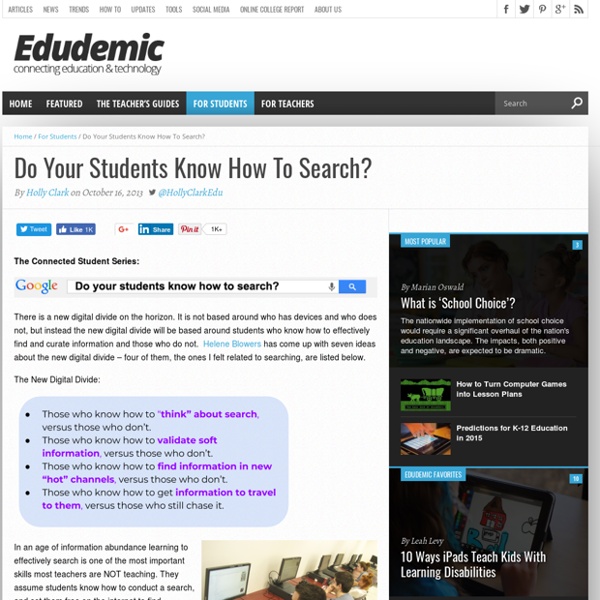Research for Learning: An 8-Step Process
Research for Learning: An 8-Step Process by Jane Healey, Ph.D. Ed note: This article has been update from a 2013 post. A recent popular magazine asked what education will be like for the class of 2025.
Search Strategy Worksheet - HSU Library
Before searching indexes and catalogs you should clarify the information you are seeking by developing a search strategy. This worksheet presents a four-step process for creating a search strategy and gives tips for entering your search in indexes or catalogs. These resources are listed under Articles and Databases and Books on the HSU Library webpage. Further information on some of the ideas presented -- free text keywords, controlled vocabulary, word truncation, boolean operators, nesting -- is found in the Research Roadmap tutorials on Topics and Searching. Creating a Search Strategy
600 Other Ways To Say Common Things: Improving Student Vocabulary -
Your students are bright, but they don’t always sound like it. Their diction is full of cliche and emaciated language that doesn’t reflect their inner voice, nor does it indicate their vocabulary level. You want your students to use specific language that demonstrates intended meaning rather than the first word that popped into their head, but you want to do more than hand them a thesaurus and tell them to “figure it out.” While the following graphics aren’t going to make that happen, they can certainly play a role if posted to your classroom blog, shared on a student-teacher pinterest page, hung on a classroom wall, or reformatted, printed, hole-punched, and stored in a student binder.
Curation tools - eLearning - The University of Queensland, Australia
What is a content curation tool? A content curation tool allow you to collect information from a variety of multimedia sources and present and organise it in a meaningful way around a particular theme. These tools allow students to sift, sort, arrange, annotate, share and publish research resources.
3 Great Chrome Apps to Help Students Effectively Search The Web
November 13, 2015 Being able to conduct smart search queries online be it on Google or any other search engine is absolutely an essential skill for the 21st century students. Smart searching is all about finding relevant and reliable content that matches your query with the minimum time possible. Google offers a wide variety of tips and tricks to help you become search savvy. Additionally, there are also some very good Chrome extensions that are also indispensable for doing online research. In today’s post we are sharing with you three of our favourite add-ons to use on your Chrome browser for a quick way to search the net. 1- Google Similar Pages
Ten Steps to Better Web Research
In June 2013, Dulcinea Media will release Teaching Web Research Skills, a research-based multimedia experience that greatly expands upon these Ten Steps. Read this blog post for more information. Educators and parents, please view our presentation on Teaching the Ten Steps.
7 Tips for Citing an App in MLA Format
Clay Shirky famously pointed out that the problem in the information landscape today isn’t necessarily that there is too much information but that our filters aren’t any good. Students feel this problem acutely due to their perpetual crunch for time and lack of nuanced Google skills. So where does a responsible student go for reliable information she can use in an academic context?
4 Promising Curation Tools That Help Make Sense of the Web
Steven Rosenbaum is a curator, author, filmmaker and entrepreneur. He is the CEO of Magnify.net, a real-time video curation engine for publishers, brands, and websites. His book Curation Nation is slated to be published this spring by McGrawHill Business.
10 Very Good Tools for Student Researchers
January 27, 2016 One of the onerous parts in essay and academic writing is the bibliography section. Managing, organizing and citing references can sometimes be a real challenge especially if you don't keep track of what and who you cite. The last thing you want after a strenuous writing task is a messy bibliography with one reference missing a page number, the other needs publication date or, worse of all, having to go back to your sources to check for the source of that quotation you included in your conclusion. If you find yourself constantly grappling with problems such as these, the web tools below are absolutely something you might need to consider. These are some of the best applications for organizing, managing, and publishing bibliographies, citations and references. Some of these softwares are integrated with Google Scholar.
Digital Storyteller
Digital Storytelling in Language Arts Authors: Glen Bull & Sara Kajder Introduction This introduction to digital storytelling in language arts is adapted from an article published in Learning and Leading with Technology. The PDF of the original article can also be downloaded: Digital Storytelling in Language Arts (pdf) A digital story consists of a series of still images that are combined with a narrated soundtrack to tell a story.




This is a good article that highlights the requirement for students have in using effective searching techniques by nicha60 Oct 24